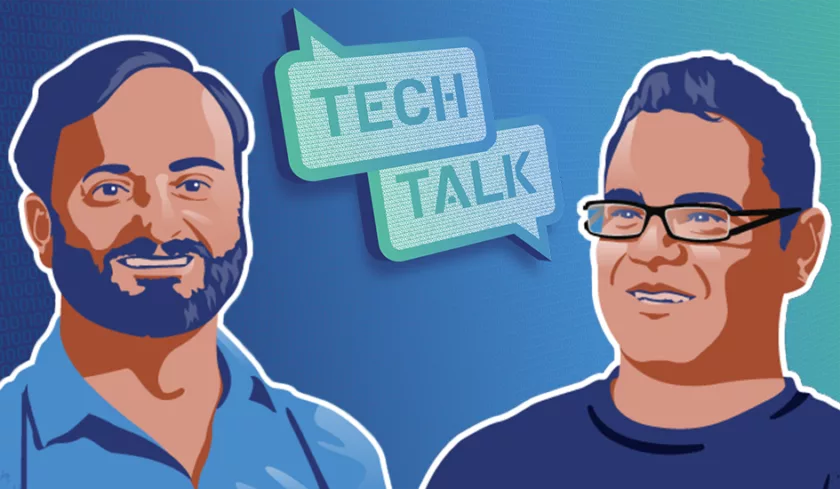
News
Meet the Re-flow Tech Leads

Looking through our site’s blog, much of the content is focused on what Re-flow can do. That’s important of course; Re-flow’s feature set is what makes our software such a valuable tool for your business’s workflow success. But what we don’t spend enough time on, is telling you the ‘How’ behind Re-flow’s award-winning software.
So, we asked our Tech leads, Lee Wade, and George Meredith, to sit down and answer nine questions about how Re-flow was designed and built; how the software has evolved and adapted; how the clients use of the software has shaped its development; and finally, where the Tech leads see Re-flow going in the future.
Re-flow’s evolution.
When discussing the early days of the software, Technical Director Lee Wade is clear, ‘the software was designed to deliver data to people in the field and keep (it) available offline.’ As Technical Manager George Meredith puts it, it was, a publishing system and so attention was put into formatting and making the data presentable.
This focus on publishing soon shifted as the software started to deliver data back from the field. George and Lee realised the value in this new data and expanded the software towards, as Lee puts it, ‘the development of complex forms and processes.’ This led to the development of many of our powerful features like asset management and remote capture, sign off and tag confirmation.
Not just another digital document system
Like with all workflow management SaaS's out there, going paperless is ‘a big part of Re-flow’s job… but there’s a lot more to our software than that.’ In fact, for Re-flow, reducing paper is just the beginning of what our software can offer. As George explains it, ‘The real world is fluid; things change at a moment’s notice.’ With paperwork, your information is becoming out of date from the moment your forms leave the printer. Any changes to timings, job details, personal, client requests, or quotes immediately make your physical paperwork obsolete.
That’s why Re-flow is designed to not only publish information out to the field, but also feed information back. That information updates job tasking and schedules, giving managers in-office a bird’s eye view of progress on all their teams across multiple sites.
Furthermore, that data can also be used to automatically generate of forms for accountancy and HR. All this can be shared by our clients to their clients through the client portal; removing the time it takes to communicate important information.
The powerhouse function of Re-flow
All the core features of Re-flow would be nothing if they weren’t able to function in the field, in all the locations that your workers need to go. Some may consider cloud-based software to be only as good as your current level internet connection signal. But that isn’t the case with Re-flow.
As George explains, ‘a lot of our competitors didn’t consider this problem when they first built their systems and so struggle to offer that feature. But we built the ability to work offline into our software from the ground up.’ All the data processes and functions happen in the forms, and when you next get connection, all the information is pushed back to the dashboard. It’s this ‘field user first’ focus that sets Re-flow apart.’
Customer Customisation
We put a lot of thought into the functions and features of our software. But we’re not the only ones who’re exploring new ways to utilise the Re-flow. According to Lee, ‘some of the actual data use cases are things we didn’t initially envision, we designed the app to schedule people to tasks and fill out related work forms. Clients have now used the app to perform HR services and even, during COVID, to enable employees to record their current health status.’
While these uses may not have been envisioned by our design team, Re-flow has proven more than capable of delivering them. This is because, as George explains, the way we designed the system was to be flexible so it can adapt to the way clients want to use it as opposed to being built with very rigid pre-set pathways. As Re-flow’s clients explore new ways of using the software, we add new features that help facilitated this, which in turn leads to more exploration.
Growth Sectors
Re-flow was developed for one client’s specific industry needs. But even early on we recognised that Re-flow’s features would be suitable for multiple industries from, from construction, civil engineering, highways, ground works, road marking, landscaping, HR and even health care.
That is why when they started working on Re-flow, George, ‘always considered different industries when building out the software. This ensured that the product would be able to work across all the industries seamlessly without feeling ill-suited for any one of them.
Recently Re-flow has seen more usage within HR departments as well as in health and safety work. As example of this Lee points to how originally, we only did things, ‘like vehicle safety checks and, plant safety checks’ the has massively expanded to cover a full gamut of risk assessments.
The stand-out Software
There are a host of software solutions on the market claiming to be the best workflow management tool. So why are we so confident that Re-flow really is the stand-out software?
For Lee, the answer lies in the skills set that he and George both brought to the creation of the software. ‘George comes with a web background and, I with a compiled language and video games one. It is the mix of these two disciplines that makes Re-flow what it is.’
Our app runs on its own native framework and render. This means that the dashboard to create a simple subset of HTML, and the app can render it out at great speeds. This, Lee continues, ‘allows the app to run smoothly even on low end devices and no part of its functionality is lost, even when working offline.
For George, this simplicity is also a key factor. ‘With design and presentation, it was always about keeping it simple and easy to use. We wanted clients to be able to pick up and use the app with little instruction. We even made sure that the synch function worked like Facebook’s so that anyone using the phone app would instantly understand how it worked.’
It is this combination of clever design and optimisation and, a simple and easy user interface that that makes us confident in calling Re-flow the industry stand-out.
The twin drivers of Re-flow’s development
As Re-flow continues its development, it remains important that the clients’ feedback stays at the forefront of the process. For George, ‘putting yourself in the position of being out in the field and thinking how you’d like the software to function and working backwards from there’ is the best way to approach development.
This ‘client first’ approach comes from the early days of our development when Re-flow had around four or five clients, all in different industries. ‘It was about finding the commonalities between the clients’ needs, putting features out there, and then using our clients’ feedback to help inform further development.’
Lee too acknowledges the importance of that early experience, and client feedback remains a key factor in the dev team’s road map. ‘The wants and pain points of the clients remain the focal point.’
However, the product’s success has meant that the development team must put its focus into ‘beefing up’ the security and stability of the software to keep pace with the ever-growing client base and data pool we handle. This growth and expansion also means that, ‘Re-flow’s development has closed a lot of the gaps between the different industry requests, creating a sort of common ground of features and functions shared by all industries.
George summarises it simply, the philosophy has always stayed the same, but the approach has to evolve. We’ll always listen to clients’ requests, but now it’s a matter of looking across the whole client based and seeing what will provide the biggest wins for everyone.’
Ad‘app’tability
As our client base grows, both in business size as well as variety, it’s crucial that Re-flow remains adaptive to be able to respond to their evolving needs.
For Lee, a large part of this is as simple as making sure the system keeps pace with the handing the extra data being pushed through and ensuring the front end doesn’t slow down or suffer performance issues, even now, with clients now often sending a thousand documents per job.
For George, adaptability is built into the DNA of Re-flow. ‘It was designed to by flexible; able to scale with the needs of the client.’ They’ll often come on board for one or two of our features, but as their user base grows, they steadily start to make use of all the other features available to them with the system.
Re-flow has also grown and adapted its feature set along client requests. In this way George frames it as Re-flow growing and adapting to accommodate its clients as they themselves, grow and ‘fill-out’ the suite of features we provide.
The future of Re-flow
A big part of Re-flow’s success lies in its forward planning. Just as in the early days, George describes designing Re-flow to be flexible to future needs. Today, the development team is looking at what can be done to future proof the software and allow us to keep our technical edge on the rest of the industry.
Lee is looking to the ‘industries and areas we can push the product and building up our flexibility to better enable that in the future.’
He is also excited to about our newer work with machine learning. This is geared towards making our forms even more powerful and gifting our clients even more value from their data.
George seeks to expand the customisability of Re-flow and place that into the clients’ hands, ‘freeing them up from having to call us to make changes and really empowering them to make the changes they want to make.’
Our team of digital transformation specialists are here to help. Call us or request our live demo.



